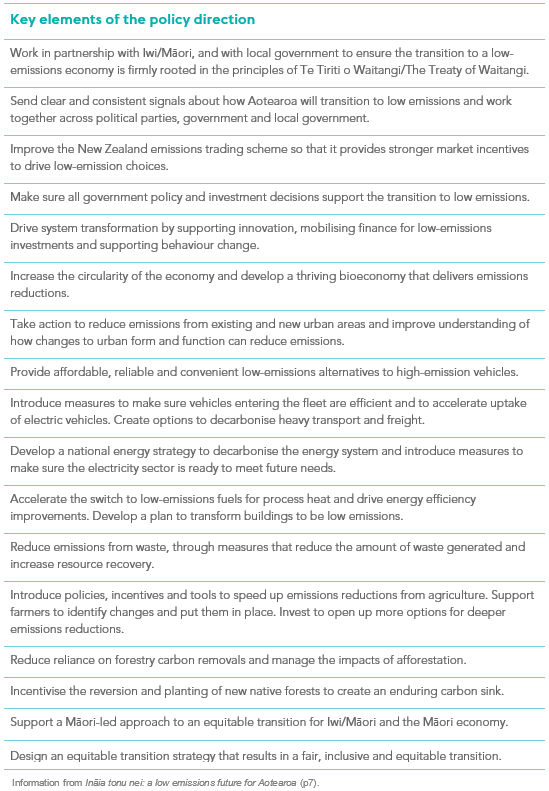Last week the Climate Change Commission, He Pou a Rangi, released its final advice on how to take New Zealand to a net zero Carbon future.
Ināia tonu nei: a low emissions future for Aotearoa has confirmed the overall thrust of its initial advice issued on 1 February 2021, subject to some notable changes:
- a steeper emission reduction trajectory due to incorrect/outdated modelling data used in the initial report;
- fuller recognition of Māori interests; and
- recommending increasing ministerial accountability at a pan-sector level.
Ināia tonu nei is a very significant pan-sector set of policy recommendations that, if adopted even in part, will fundamentally change New Zealand's economy and society. The bulk of the Commission's recommendations are also over very short timescales (1-2 years) which would mean locking in a very busy term for this Government if even half of the recommendations are adopted.
Now that the Government has received the advice, the Government is required by law to finalise its emissions reduction plan for the period 2022-2025 by the end of the year. We are expecting the Government's proposed emissions reduction plan to be consulted on in the second half of 2021.
Below we set out some of its key recommendations and provide insights on the Commission's final advice. We then look to the second half of the year and the important policy changes that we are already expecting relating to emissions reductions.

Cross-sector policies
The Emissions Trading Scheme (ETS) remains the key lever for driving emmisions reduction for the Commission, and its recommendations remain that the ETS should be strengthened both in terms of its governance but also the price of units under the scheme.
Profits from the auctioning of units (held for the first time this year) will be recycled back into adaptation and mitigation projects. The Commission also recommends evaluating the extension of mandatory climate-related reporting to public entities and emissions enabled by loans over a certain amount from financial institutions.
Transport
The Commission identifies that investment in infrastructure, behaviour change and technology will create opportunities to decarbonise transport by 2050. This will be spearheaded by reducing reliance on internal combustion engine private vehicles through supporting active and public transport and EVs as well as the development and production of alternative fuels such as biofuels and green hydrogen.
Decarbonising heavy transport and freight is recommended, which will present opportunities for rail and coastal shipping operators and the Commission has identified the need for growth in those sectors to meet anticipated demand.
The potential decarbonisation of shipping and aviation sectors presents a challenge for shipping lines, ports, airlines and airports – there is currently no viable sustainable aviation fuel for supply in New Zealand. Outside of the Commission's findings that small electric aircraft will be operational by 2030 for potential regional flights, there is no practical roadmap to decarbonise shipping and aviation, and the Commission recommends an Aotearoa-specific study is completed next year to create a strategic pathway towards decarbonisation.
Energy
The Commission has recommended development of a national energy strategy by 2024 to create a pathway to reaching 50% renewable energy by 2035 and has once again confirmed that the Government's goal of 100% renewable electricity is aspirational, and that 95%-98% is more achievable and effective.
Modelling of the energy sector has been readjusted based on updated information relating to the closure of Tiwai and Methanex. Interestingly, Lake Onslow is only mentioned twice in the final report, and the Commission appears to have listened to feedback that such a substantial government-sponsored electricity generation project would have catastrophic effects on private investment in additional renewable energy infrastructure and cause chaos to electricity pricing in New Zealand.
There are some signs that the Commission is also beginning to grapple with the regulatory settings required for a build out of the transmission network and new renewable generation assets.
Industry
The reduction of emissions from low- and medium-temperature process heat activities is identified as being critical for meeting the 2050 emissions reduction target. The Ministry for the Environment's introduction of changes to the Resource Management Act to ban new coal assets plays a large role in this. However, the Commission's advice on decarbonising difficult to abate industries lacks practical solutions and does not lend itself to producing a practical pathway forward for some industrial activities.
Instead, the Commission recommends significant investment in research and development to identify cost-effective approaches to reduce emissions associated with industry. The Commission relies heavily on new technology (for industry, but also predominantly in aviation, shipping and agriculture), which cuts across the Commission's statements that goals can be met using currently available technology.
Buildings
The Commission has recommended pushing on with MBIE's work to decarbonise the construction sector. In addition to the recommendation to phase out the use of fossil gas in existing residential, commercial and public buildings, the adoption of low-emissions building designs and construction is identified to reduce energy use and embodied emissions.
Accounting for embodied carbon will be a very significant step for entities involved in both public and private projects, and it will require renewed focus on the emissions throughout the construction supply chain.
Waste
The Commission has recommended increasing targets on waste operators to reduce biogenic waste methane emissions by at least 40% by 2035. This change has come in response to feedback received and modelling updates, with gains to be achieved through landfill management, including making landfill gas capture for landfills that accept organic waste mandatory by 2026. This will be one of many challenges that local governments will face in the wake of ināia tonu nei and on the journey to net-zero 2050. Further investment is also needed in resource recovery infrastructure to ensure we are recycling what we can.
Another measure where New Zealand lags behind internationally (eg compared with the EU) is product stewardship, and the Commission has recommended a product stewardship programme be introduced.
Agriculture
The Commission's clear message is that the pathway to reducing emissions in agriculture depends on pricing emissions and technology advancements:
-
Ināia tonu nei supports the Government's commitment to determine a pricing mechanism for agricultural emissions in 2022, which will provide farmers and growers with the certainty to plan accordingly and reduce emissions in the short term. This is being led by He Waka Eke Noa which is currently assessing how emissions can be calculated at a farm-scale level.
-
Technology such as breeding low emission ruminants or the use of methane inhibitors will be important in preserving farming productivity while also reducing emissions. This technology is not currently readily available to farmers and will take time and money to develop. As noted above, while this represents a reality for the agricultural sector, it runs counter to the Commission's narrative that goals can be met using currently available technology. In this regard Government, industry groups and collectives will have a key role to play in assisting farmers' transition to a new way of doing business that reduces methane emissions.
Forestry
Forestry continues to be identified as playing a significant role in meeting emissions budgets and the 2050 emissions reduction targets, in being the only way to remove carbon dioxide from the atmosphere that is currently available at scale.
Despite the clear recommendation by the Commission that massive amounts of new afforestation are required, the Commission remains cautious about not encouraging "too much" plantation afforestation. Strict land use and economic controls is recommended by the Commission to ensure that pinus radiata does not encroach on native forests as the predominant forest in New Zealand.
This position is difficult to understand, particularly given submissions on this point were clear that exotic afforestation will need economic and policy support if the Commission's goals are to be reached. The Commission's advice also fails to recognise and incentivise under the ETS pest management and the creation of harvested wood products.
The policy support required to support even larger amounts of native afforestation is still its infancy, and the Commission has recommended the Government develop proposals for incentives for native forests by the end of next year. This will be a key carbon sink for New Zealand, and the policies to achieve this will be critical given that there is no 'plan B' if native afforestation does not occur.
Pipeline of policy in Q3 and Q4 2021
Even prior to the release of the Government's emission reduction plan, we are expecting a congested pipeline of policy proposals to be released for consultation in the second half of the year, including:
-
Reform of the Resource Management Act is underway already and will include addressing climate change as a key outcome. The core principles of the new Natural and Built Environment Act is expected by the end of June 2021.
-
The Government will be releasing draft national direction under the Resource Management Act on the consideration of greenhouse gas emissions from industrial heat processes and non-binding guidance on emissions from other types of activities in the third quarter.
-
The Ministry of Transport has released its consultation document Hīkina te Kohupara Transport Emissions: Pathways to Net Zero by 2050, which sets options and policies that can be used to phase out emissions across the transport system. Submissions close on 25 June 2021.
-
New Zealand Infrastructure Commission released the He Tūāpapa ki te Ora: Infrastructure for a Better Future document in May 2021, supporting the facilitation of decarbonised infrastructure. Submissions close on 24 June 2021.
-
MFE is expected to release climate risk scenario guidance for the New Zealand financial and corporate sectors by the end of the year to support impending new climate-related reporting standards (which the External Reporting Board is due to begin consulting on in early 2022).
Please contact our experts to discuss this update or any policy developments with us further.



